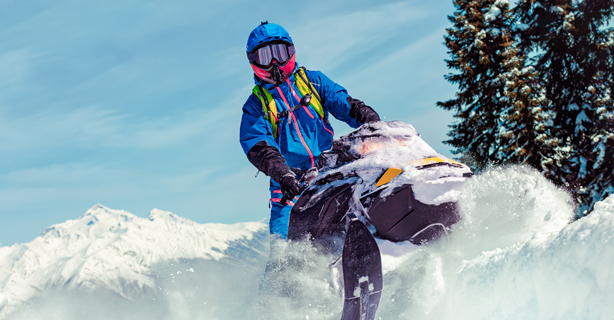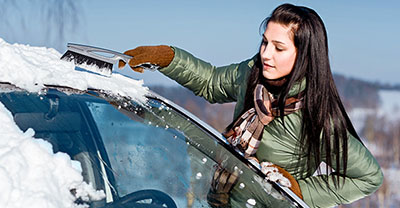10 snowmobile essentials for winter riding


Ready to tackle snowy landscapes on your snowmobile? Before you rush out into a winter wonderland, you need the right gear and equipment for a safe, comfortable ride. We've rounded up ten essential pieces to get you started:
1. Snowmobile helmet
A helmet is among the most critical pieces of gear for snowmobiling, since it helps protect your head from potential impacts in case of accidents. According to a recent summary published in the British Medical Journal, patients wearing helmets reduced their odds of needing inpatient admission by 63%, compared to those who weren’t wearing helmets at the time of the accident.
When choosing a snowmobile helmet, consider the following:
Snowmobile-specific design: Look for a helmet specifically designed for snowmobiling. These helmets offer features tailored to the unique requirements of snowmobilers, including vents that can help reduce fogging.
Full coverage: Ensure the helmet provides full coverage, including a sturdy chin guard and visor, to help protect your face and eyes from potential injury and sun glare.
Proper fit: A snowmobile helmet should fit snugly on your head without feeling uncomfortably tight or wobbling when you move your head. Try different sizes and models, if necessary, to find the helmet that’s right for you.
Certification: Make sure your helmet has been certified by the U.S. Department of Transportation (DOT) or The Snell Foundation, a respected nonprofit organization that tests and certifies helmets. If a helmet is labeled certified by one of these two organizations, it means it’s met the certifier’s safety standards.
2. Snowmobile suit
To stay warm and dry while out on the trails, wearing a one-piece snowmobile suit is ideal, especially in extremely cold weather. That said, a ski jacket or other heavy coat and snow pants can also work well. When choosing a snowmobile suit or other protective clothing, focus on the following attributes:
Waterproof and windproof: Look for a suit made with waterproof and windproof materials to help keep you dry and shielded from harsh weather conditions.
Insulation: Ensure the suit provides enough insulation to keep you warm. Look for suits with quality insulation materials, such as Thinsulate** or down.
Adjustable cuffs and high collar: Choose a suit with adjustable cuffs and a high collar to seal out cold air and snow.
3. Goggles
Goggles help protect your eyes from wind, snow, and debris. Keep the following in mind during your search for the perfect pair of snowmobile goggles:
Anti-fog and anti-scratch features: Opt for goggles with anti-fog and anti-scratch coatings on the lenses.
Helmet compatibility and comfort: Choose goggles that work with your snowmobile helmet. Look for a snug, secure fit that doesn't obstruct your peripheral vision. Adjustable straps and foam padding can enhance comfort and prevent goggles from shifting during rides.
Lens color: Certain lens colors are better suited for different types of riding conditions. For example, in bright conditions, go with dark grey or brown to add contrast, with a solid mirror to help reduce glare. In low light or flat light, a warmer lens color—like yellow or amber—can help improve your visibility.
Wide field of view: Goggles with a wide viewing area can provide better visibility of your surroundings. This is especially important for navigating trails and spotting obstacles or other riders.
Get a free snowmobile insurance quote.
4. Winter gloves
Good snowmobile gloves keep your hands warm and dry while still allowing decent range of motion and grip. Look for gloves with the following features:
Insulation: Gloves with quality insulation materials are essential for maintaining dexterity and preventing frostbite.
Waterproof or water-resistant outer layer: Ensure the gloves are either waterproof or water-resistant to help keep your hands dry in snowy or slushy conditions.
Adjustable wrist closures: Opt for gloves with adjustable wrist closures that allow you to customize the fit, keeping snow and cold air out while securing the gloves.
5. Boots
Invest in quality snowmobile boots to keep your feet warm, dry, and protected. Look for boots that are:
Waterproof: Waterproof boots can help keep your feet dry even when riding through wet, melting snow.
Insulated: Insulated boots are key to maintaining warmth and preventing frostbite on long, cold rides.
Sturdy: A durable, rugged outsole is crucial for traction and stability on slippery snow and ice patches.
6. Hand warmers
Hand warmers are a worthwhile—and inexpensive—addition to your snowmobile gear. They provide extra warmth and comfort during cold rides. You can place disposable or reusable hand warmers in your gloves or pockets to keep your hands cozy.
Be sure to follow the manufacturer's instructions for optimal effectiveness and safety.
7. Snowmobile cover
A snowmobile cover is essential for protecting your snowmobile from snow, ice, and UV damage between rides.
Choose a durable, waterproof cover that fits your snowmobile correctly. Check with your snowmobile’s manufacturer for a cover designed specifically for your model. Look for covers with ventilation technology to help prevent condensation and mildew. A well-fitted cover can also help guard against nesting rodents.
8. First aid kit
There’s no good time or place for an injury or medical emergency—but miles from home in subfreezing temperatures is one place you don’t want to get caught without a basic first aid kit.
Carrying a compact first aid kit is essential for any outdoor adventure, including snowmobiling. Most sporting goods stores sell prepackaged first aid kits, but you can also pack your own. Either way, make sure it includes:
Bandages
Adhesive tape
Antiseptic wipes
Gauze pads
Tweezers
Necessary prescription and over-the-counter medications
Thermal blanket
Emergency contact information
9. Tool kit
A simple tool kit can help you handle minor repairs or adjustments on the trail, reducing your likelihood of ending up stranded. Along with snowmobile-specific tools—many of which you can purchase from the manufacturer or a local snowmobile dealership—include items like:
Multi-tools
Wrenches
Pliers
Spare spark plugs
Spare belt
Zip ties
Tow rope
Flashlight with spare batteries
10. GPS and communication devices
Navigating through snowy landscapes can be challenging, especially in unfamiliar areas. A GPS device provides reliable navigation and helps you stay on the right path. Consider devices specifically designed for snowmobiling that offer detailed maps and trail information. Additionally, bring a communication device such as a two-way radio or satellite phone to stay connected and call for help in case of emergencies—even when you lose cell phone service.
Bonus: Snowmobile insurance
Snowmobiling is a thrilling winter activity, but it brings its share of risks. Protecting yourself, your fellow riders, and your snowmobile itself is essential. Snowmobile insurance can help protect you financially in case of an accident, and can provide you with peace of mind while enjoying your ride. If you don’t already have snowmobile insurance, consider the following coverages:
Bodily injury liability
This coverage can help protect you if you injure another person while operating your snowmobile. It can help cover your legal expenses and the other person’s potential medical costs.
Collision
While liability insurance can help pay for other people’s injuries or damages following a covered accident, collision coverage applies if your own snowmobile needs to be repaired or replaced. Collision coverage applies if your snowmobile is damaged due to a collision with another snowmobile, a stationary object, or even if it overturns. This coverage typically applies regardless of fault.
Comprehensive
Comprehensive coverage can help protect you financially if your snowmobile is damaged by something other than a collision, such as theft, vandalism, fire, or damage caused by severe weather conditions like hail or flood.
The general information in this blog is for informational or entertainment purposes only. View our blog disclaimer.
*Data accuracy is subject to this article's publication date.
**All product names, logos, brands, and trademarks are property of their respective owners. All company, product, and service names are for identification purposes only. Use of any of the foregoing does not imply endorsement.









